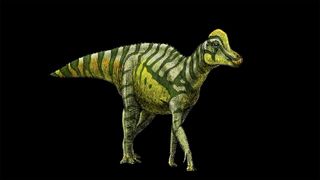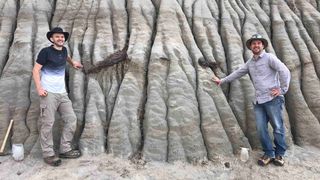Rare fossils reveal basketball-like skin on duck-billed dinosaur
“I’ve never seen anything like it; I was completely blown away.’

Finding a dinosaur fossil with preserved soft tissue is incredibly rare, so when a team of researchers in Alberta, Canada, unearthed a hadrosaur — a duck-billed herbivorous dinosaur — with not only a near-complete skeleton but also with patches of pebbly-textured skin still intact, they knew they had stumbled upon a once-in-a-lifetime discovery.
"I've never seen anything like it," Brian J. Pickles, an associate professor of ecology at the University of Reading in the United Kingdom, who was scouting the area with some of his students, told Live Science.
When he caught his first glimpse of the fossil, he "was completely blown away."
Measuring 13 feet (4 meters) in length, the specimen died approximately 76 million years ago while roaming what was once a complex river system that crisscrossed the landscape during the Cretaceous period (145 to 66 million years ago). Today, that same area is known as Dinosaur Provincial Park, a UNESCO World Heritage Site that is recognized as a hotbed of dinosaur fossils. Some 400 to 500 dinosaur skeletons or skulls have been found in the area, according to CBC/Radio Canada, Canada's national public broadcasting station.

Pickles suspects that the abundance of sandstone and silt covering the fossils is what helped with their impeccable preservation; the skeleton includes "a big chunk of the tail and one of its hind limbs at the surface of the rock, which is starting to pop out," he said.
"I think [the specimen] was covered quite quickly, otherwise it wouldn't be this well preserved," Pickles explained. "You can see some of its vertebrae and tendons, and once you get closer, you can see some of its scales. The dark, scaly skin has a basketball-like texture. This is something really special; you don't find things like this very often out in the field."
Related: What color were the dinosaurs?
Sign up for the Live Science daily newsletter now
Get the world’s most fascinating discoveries delivered straight to your inbox.
An adult hadrosaurs is typically at least twice the size of this particular specimen. That suggests the newly discovered hadrosaur was a juvenile, which adds an additional layer of intrigue to the discovery.
"It's rare to find juvenile fossils," Pickles said, "because typically dinosaurs grow quite quickly, and we usually find the remains of adults."

Pickles told Live Science that Teri Kaskie, an environmental specialist and a volunteer member of the excavation team, "came across the fossils by chance" last August when she spotted some of the bones poking out from the hillside. This year, Pickles and several of his students from the university returned to Canada to excavate the rest of the dinosaur, a lengthy process that could require one more field session next summer to complete. And while the researchers suspect that an intact hadrosaur skeleton lies buried in the rocky matrix, it won't be possible to confirm that until their work is done.
"So far, we've removed 100 imperial tons [112 tons] of rocks, which we call overburden, to get to the fossils," Pickles said. "We think the whole [skeleton] is there but we won't know for sure until we complete the excavation."
Ultimately, the hadrosaur will end up as part of the permanent collection at the Royal Tyrrell Museum in Drumheller, a town located to the northeast of Calgary.
"It's important when you get a specimen like this, since it tells you more about the animal than just its bones would," he said. "Of course, finding skeletons is great, but finding the skin and preserved soft tissues tells us more about the ecology of these animals. They weren't a bunch of skeletons walking around millions of years ago. They were living, breathing animals."
Originally published on Live Science.

Jennifer Nalewicki is a Salt Lake City-based journalist whose work has been featured in The New York Times, Smithsonian Magazine, Scientific American, Popular Mechanics and more. She covers several science topics from planet Earth to paleontology and archaeology to health and culture. Prior to freelancing, Jennifer held an Editor role at Time Inc. Jennifer has a bachelor's degree in Journalism from The University of Texas at Austin.
